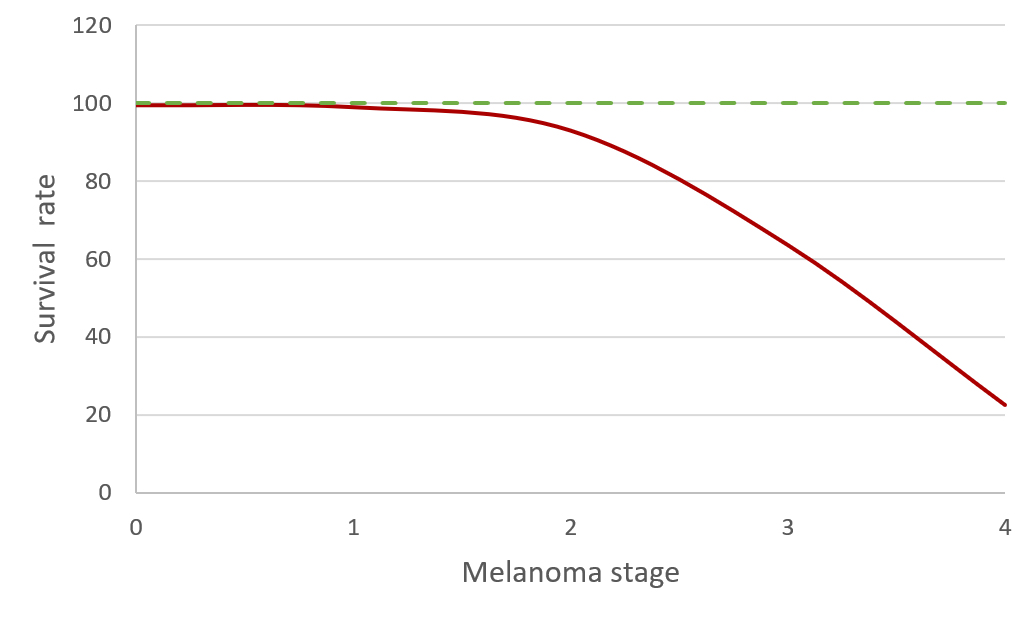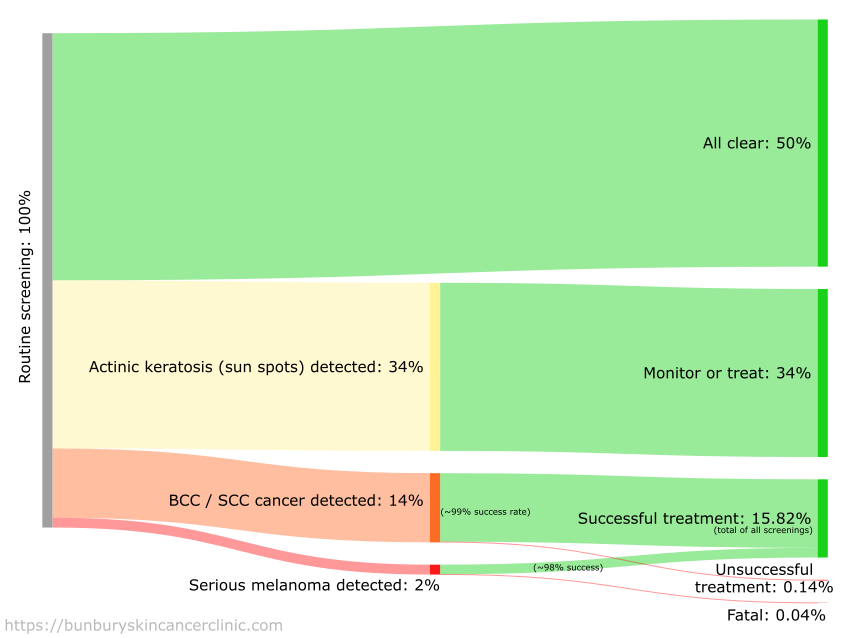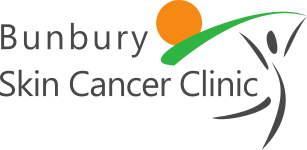Why get a skin check?
Australia has the highest rate of skin cancer in the world. Every year over 430,000 Australians are diagnosed with skin cancer. Whilst most skin cancers are relatively benign, about 1% of skin cancers are an aggressive type of cancer called melanoma.
Each year, over 1,600 people will die from Melanoma. Melanoma starts as a small growth in the skin, but later spreads to other parts of the body. If melanoma is detected early, the odds of survival are very good, typically above 95%. However, if the melanomia is detected late, the chances of survival are poor, about 20 – 60%.
Regular skin checks are an important tool for early detection of melanoma and other skin cancers.

Melanoma survival odds, early vs late detection.
Why chose a dedicated skin clinic for my skin check?
Bunbury Skin Cancer Clinic is dedicated to skin cancer. Our medical practitioners started as doctors in general practice, but have gone on to complete extensive training specifically in skin cancer medicine, and are now entirely focused on skin cancer diagnosis and treatment. Each of our medical practitioners will conduct thousands of skin checks per year. Skin cancer screenings can be challenging, but you can be assured that our medical practitioners conduct their screenings with a high degree of accuracy, and also a decreased possibility of false alarms and unnecessary surgery.
What to expect during a skin check?
A skin cancer check will involve undressing to your underwear. The medical practitioner will routinely displace underwear briefly, to inspect breast, buttocks or lower abdominal skin without fully removing the garments. The skin cancer examination will not routinely include examination of the genital or nipple area, however you may request that these areas are examined if you have concerns about any moles or suspected lesions.
It is also a requirement that you remove all make-up, including nail varnish prior to examination, as this may mask early detection of skin cancer such as melanoma under nails. Soles of the feet need to be examined without socks or stockings.
The medical practitioner will use a dermatoscope and examination lights to conduct a close examination of your skin.
Typical screening results
This graph illustrates summary results, averaged over many different skin checks conducted by BSCC medical practitioners.

Key takeaways from these results:
- One person in every two will have actinic keratosis (sunspots), which indicate damage to the skin, and can later develop into cancers.
- One in seven people will be found to have a non-melanoma skin cancer at time of screening (SCC or BCC). Early detection is associated with less invasive or complex treatment, and improved cosmetic outcomes following treatment.
- One person in every fifty will be found to have a potentially-fatal melanoma, usually found in the very early stage. Sometimes these cancers are located in odd places, such as on the soles of the feet or underneath fingernails.
- With early detection, the survival odds for the people with melanoma are good (> 95%).
What if a suspected skin cancer is found?
If any suspected cancers are found, the medical practitioner will discuss the treatment options with you. In many cases, a diagnosis is very clear from visual inspection using a Dermatoscope. In these cases, the cancerous lesion is normally removed surgically and sent away for biopsy for confirmation.
In some other cases, the lesion may exhibit some visual characteristics of a skin cancer, but cannot be definitively diagnosed without a sample being examined in a pathology lab. In these cases, the lesion may be removed surgically, or if the lesion is large, a small sample may be taken and sent away for biopsy.
Skin cancer removal (excision)
If any suspected cancers are found, the medical practitioner will discuss with you about your treatment options. In most cases, Bunbury Skin Cancer Clinic can remove the skin cancer in the clinic, without referral to a specialist surgeon. In this simple medical procedure, the tissue surrounding the lesion is numbed using a local anesthetic. A scalpel is used to remove the lesion , and the wound is closed by two layers of sutures including deep absorbable sutures so as to produce a strong wound with reduced likelihood of rupture or excessive scarring.
Every effort is made to minimise the potential for scarring, particularly on visible areas such as the face. In some cases, the medical practitioner may need to take a skin graft from a less visible area to provide enough skin to cover the removed area.
Large and or poorly defined cancers in difficult areas such as the nose are sometimes best treated by a Mohs micrographic surgeon in Perth or referred for radiotherapy where appropriate
Skin cancer biopsy
All suspected cancers are sent away to a pathology lab for biopsy. Generally the results are received within 1-2 days. You will receive a call advising you of the diagnosis and any follow-up actions.
More information
For more information about skin cancer and the role of skin checks, we recommend you review the information at the Cancer Council (Australia), or the information at our own website.
Please contact us if you would like to book your skin check.
